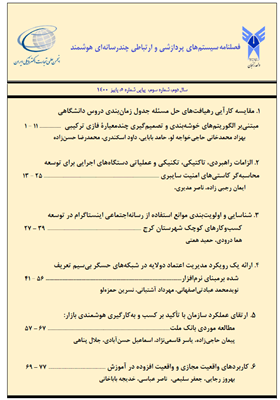ارتقای عملکرد سازمان با تأکید بر کسب و بهکارگیری هوشمندی بازار: مطالعه موردی بانک ملت
محورهای موضوعی : پردازش چند رسانه ای، سیستمهای ارتباطی، سیستمهای هوشمندپیمان حاجی زاده 1 * , یاسر قاسمی نژاد 2 , اسماعیل حسن آبادی 3 , جلال پناهی 4
1 - استادیار دانشگاه آزاد واحد تهران جنوب، گروه مدیریت صنعتی، تهران، ایران
2 - دانشگاه امام حسین (ع)، دانشکده مدیریت ، تهران، ایران
3 - دانشگاه آزاد شهر قدس، دانشکده کامپیوتر، تهران، ایران
4 - موسسه آموزشی و تحقیقاتی صنایع دفاعی، تهران، ایران
کلید واژه: عملکرد سازمانی, بانک ملت, هوشمندی بازار,
چکیده مقاله :
تحولات دنیای پرشتاب کنونی در عرصههای علمی و فنی و همچنین؛ چالشهای پیدرپی نظامهای اقتصادی و مالی، موجبات توجه عمیقتر سیاستگذاران و اندیشمندان به توسعه هوشمندی بازار در سازمانها را فراهم کرده است. در این راستا، فعالیتهای هوشمندی بازار که شامل تولید و انتشار هوش بازار در زمینه توسعه محصولات جدید است، میتواند شانس موفقیت و اثربخشی نوآوری را افزایش دهد. با این توصیف، هدف تحقیق حاضر بررسی رابطه عملکرد شرکت با کسب و بکارگیری هوشمندی بازار در ادارات کل تخصصی بانک ملت شهر تهران است. جامعه آماری پژوهش حاضر شامل؛ مدیران، معاونین و کارشناسان ادارات کل بانک ملت در شهر تهران میباشد؛ حجم نمونه پژوهش با استناد به فرمول کوکران و با روش نمونهگیری تصادفی، 253 نفر تعیین شده است. نظرسنجی از جامعه آماری پژوهش با استفاده از پرسشنامه انجام پذیرفت و برای تعیین اعتبار پرسشنامهها، از روش روایی محتوا استفاده شد و همچنین پایایی آن نیز با استفاده از ضریب آلفای کرونباخ به میزان 931/0 تخمین زده شد. نتایج این پژوهش حاکی از آن است که بین کسب و بکارگیری هوشمندی بازار و عملکرد شرکت، بین بکارگیری هوشمندی بازار و عملکرد نوآوری، بین عملکرد نوآوری و عملکرد بازار و بین عملکرد بازار و عملکرد شرکت؛ ارتباط مثبت و معناداری وجود دارد.
Introduction: The developments of the current fast-paced world in the scientific and technical fields, as well as the successive challenges of the economic and financial systems, have caused policymakers to pay deeper attention to the development of market intelligence in organizations. In this regard, market intelligence activities, which include the production and dissemination of market intelligence in the field of new product development, can increase the chances of success and the effectiveness of innovation. Hence, this paper examines the relationship between company performance and the acquisition and use of market intelligence in the specialized general offices of Bank Mellat in Tehran.Method: The statistical population of the current research includes managers, assistants, and experts of the general offices of Bank Mellat in Tehran. The sample size of the research is 253 people based on Cochran's formula and the random sampling method. A survey of the statistical population of the research was conducted using a questionnaire, and the content validity method was used to determine the validity of the questionnaires, and its reliability was also estimated to be 0.931 using Cronbach's alpha coefficient.Results: The results of this research indicate that there is a positive and significant relationship between the acquisition and use of market intelligence and company performance, between the use of market intelligence and innovation performance, between innovation performance and market performance, and between market performance and company performance.Discussion: Considering the importance of acquiring and applying market intelligence, this research was conducted with the aim of investigating the relationship between market intelligence and company performance. The first hypothesis of this research stated that there is a significant relationship between the acquisition of market intelligence and the application of market intelligence. The second hypothesis of the current research emphasized that there is a significant relationship between the acquisition of market intelligence and company performance. The third hypothesis stated that there is a significant relationship between the use of market intelligence and company performance. The fourth hypothesis stated: There is a significant relationship between the use of market intelligence and innovation performance. The fifth hypothesis is that there is a significant relationship between the difficulty of market intelligence measures and the relationship between the application of market intelligence and innovation performance. The sixth hypothesis states that there is a significant relationship between innovation performance and market performance. The seventh hypothesis stated that there is a significant relationship between market performance and company performance. The eighth hypothesis is that there is a significant relationship between innovation performance and company performance. The ninth hypothesis stated: There is a significant relationship between intelligent competitive actions and company performance.
_||_

